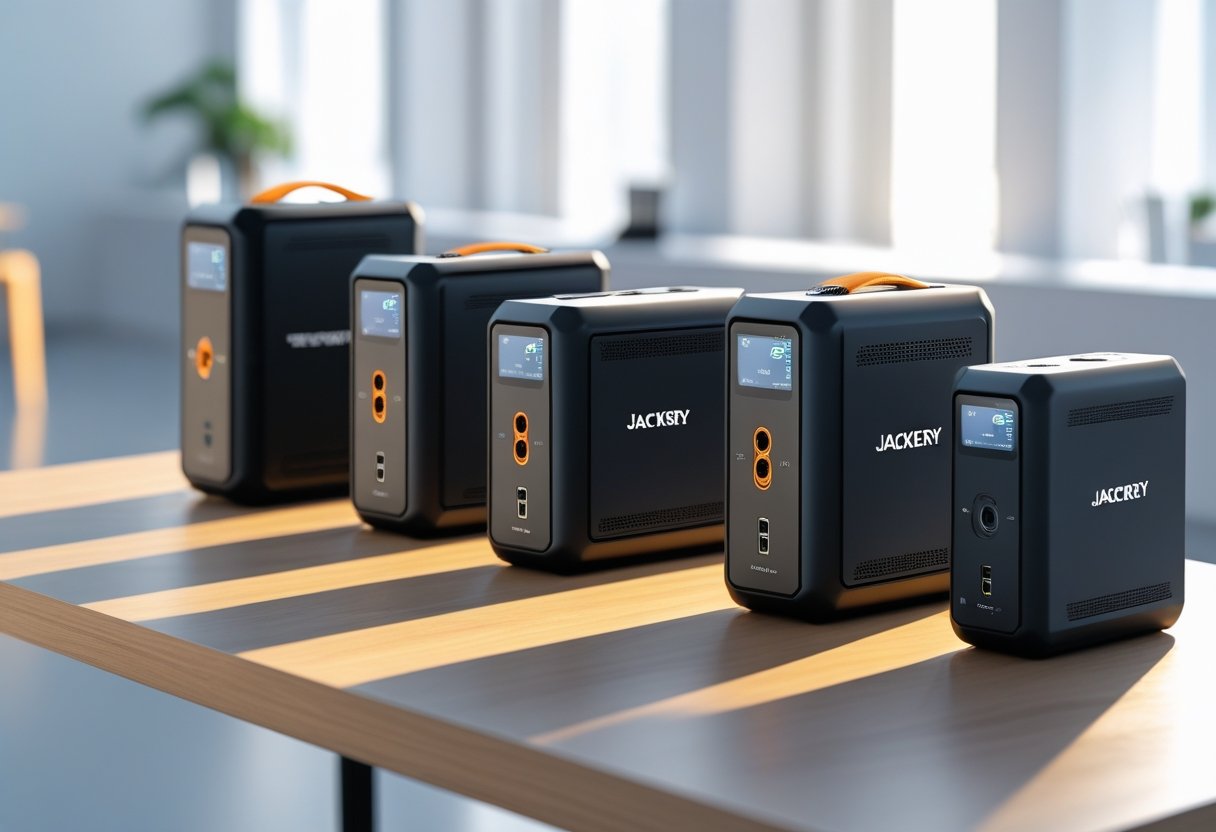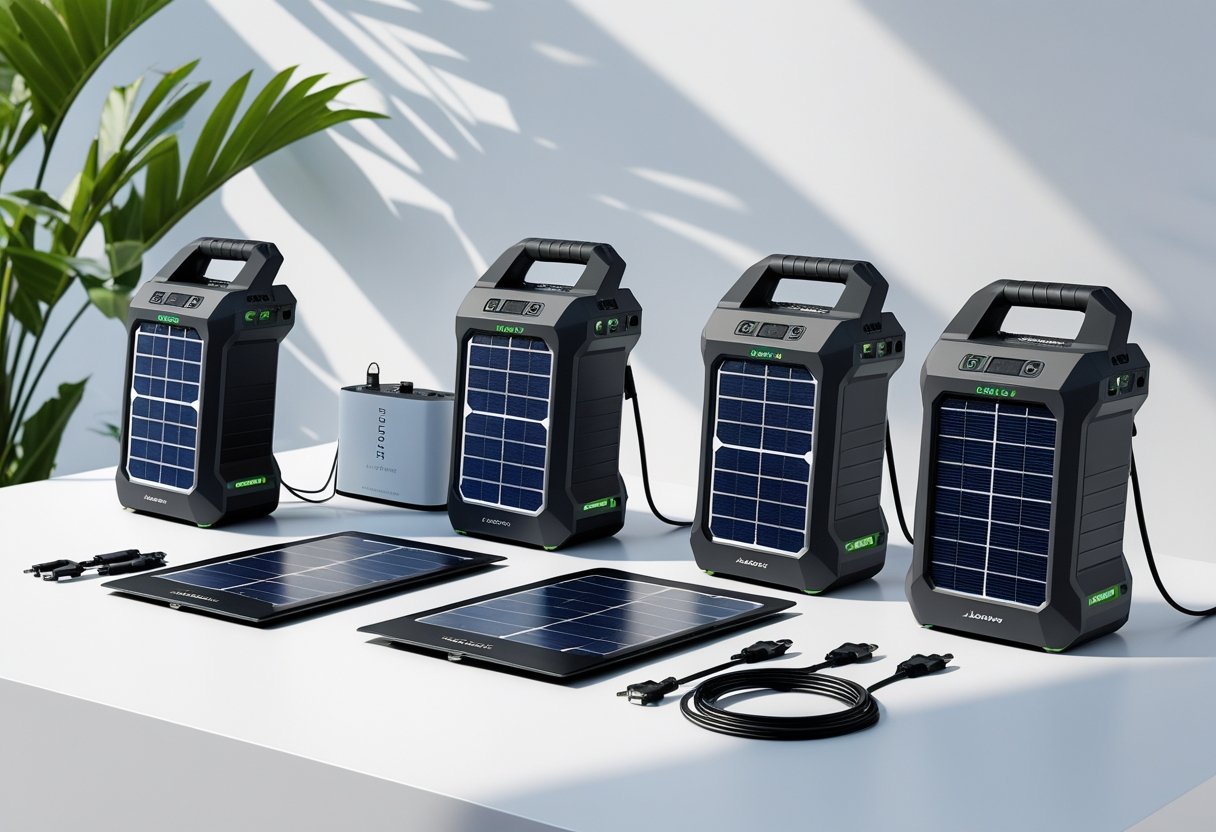The Jackery Explorer series offers a range of portable power stations designed for different needs, from camping trips to emergency backup. Each model varies in capacity, charging speed, and portability, making it important to understand the key differences before choosing one. The best choice depends on balancing power output, battery capacity, and recharge options suited to the user’s specific demands.

Some models excel in fast charging, like the Explorer 1000 Plus, which can recharge fully in about two hours when paired with solar panels. Others, such as the smaller Explorer 300, prioritize compactness for short-term use but offer less power. Comparing features across the series helps clarify which unit delivers the optimal combination of performance and convenience.
Understanding these distinctions makes it easier to select the right power station without overspending or compromising on essential functionality. Those interested can explore a detailed comparison of the Jackery Explorer models to identify which fits best for their outdoor or emergency power needs. For example, detailed feature comparisons can be found on the Jackery website.
Overview of the Jackery Explorer Series
The Jackery Explorer Series offers a range of portable power stations designed to provide reliable, on-the-go power. These devices are built with advanced technology and practical features that meet diverse energy needs, from outdoor activities to emergency backup. The series stands out for its balance of capacity, portability, and charging options.
Key Features and Technologies
Jackery Explorer portable power stations use lithium-ion battery technology, providing a durable and efficient energy source. They feature multiple output ports, including AC outlets, USB-A, USB-C, and 12V carports, enabling users to charge a broad array of devices simultaneously.
Rapid recharging is a notable technology, especially in newer models like the Explorer 1000 Pro, which offers faster wall charging compared to earlier versions. Solar input capability allows the units to recharge via compatible solar panels, supporting off-grid power needs.
The devices include smart battery management systems that optimize charging and safeguard against overcurrent and overheating. Lightweight designs and sturdy exteriors add to their portability and durability for outdoor use.
Common Applications
Jackery’s portable power stations are widely used for camping, hiking, and outdoor adventures where access to electricity is limited. They power essentials such as smartphones, tablets, small appliances, and medical devices.
Home emergency backup is another key use. During power outages, these units can keep critical electronics running for hours. They are also popular with remote workers who need reliable, clean energy in locations without direct power.
Small-scale off-grid living and van life setups benefit from the combination of portability and solar charging. The Jackery Explorer models cover a variety of power capacities, making them adaptable to different scenarios and energy demands.
Portable Power Stations in the Market
The Jackery Explorer series competes with other brands by focusing on user-friendly interfaces and reliable performance. Models like the Explorer 300 and 1000 provide various capacity options that balance charge time and output power.
Compared to competitors, Jackery emphasizes lightweight design without sacrificing battery capacity. It often integrates faster wall and solar charging options, an advantage over older or basic models from other manufacturers.
Pricing tends to be competitive for quality, particularly during sales events. Reviews highlight Jackery’s effective customer support and product durability. For an in-depth comparison of specific models and features, the Jackery comparison page provides detailed specifications.
Comparing Popular Jackery Explorer Models
Jackery’s Explorer series offers varying capacities and features tailored for portability, power output, and endurance. The Explorer 3000 Pro and 2000 Plus stand out for larger power needs, while the Explorer 300 Plus suits light, everyday use or emergency backups. Each model balances battery chemistry, weight, and output to meet different user demands.
Explorer 3000 Pro vs. Explorer 2000 Plus
The Explorer 3000 Pro delivers a substantial 3024Wh capacity with a 2200W continuous inverter output, ideal for heavy-duty use and extended off-grid power. It uses lithium iron phosphate (LiFePO4) batteries for longer life cycles and improved safety. The device also supports multiple fast-charge inputs, including solar, wall, and car charging.
In comparison, the Explorer 2000 Plus offers 2160Wh capacity and a 2200W inverter output. It also uses LiFePO4 technology but is lighter and more portable than the 3000 Pro. It supports solar charging up to 500W and provides multiple USB-C and AC outlets for device versatility.
| Feature | Explorer 3000 Pro | Explorer 2000 Plus |
|---|---|---|
| Battery Capacity | 3024Wh | 2160Wh |
| Inverter Output | 2200W continuous | 2200W continuous |
| Battery Type | LiFePO4 | LiFePO4 |
| Solar Input | Up to 900W | Up to 500W |
| Weight | Approx. 38.6 lbs | Approx. 43 lbs |
Both models prioritize high output and durability, but the 3000 Pro offers more capacity and faster solar input, suitable for longer off-grid scenarios.
Explorer 300 Plus Highlights
The Jackery Explorer 300 Plus is a compact, lightweight unit with a 293Wh battery capacity and a 300W inverter output. It is designed for portable power needs such as charging smartphones, laptops, or small appliances during outdoor activities or minor power outages.
It features multiple USB ports including USB-C, making it versatile for modern devices. Its weight under 7 lbs makes it easy to carry for camping or short-term emergency use. The Explorer 300 Plus supports solar charging but at a lower wattage, making it less suitable for sustained heavy loads compared to the larger models.
This model is best for users needing reliable, lightweight power without the bulk of larger stations.
Portable Power for Back-Up and Emergency Use
The Explorer series caters well to back-up power needs by offering quiet, emission-free operations with instant power availability. Smaller models like the Explorer 300 Plus serve as emergency power sources for phones, medical devices, and small electronics.
Mid- to large-capacity models such as the Explorer 2000 Plus and 3000 Pro handle appliances, lights, and even power tools during outages. Their multiple output ports and compatibility with solar panels provide flexibility for continued use during extended blackouts.
When selecting a unit for back-up, capacity, portability, and recharge options are critical. Jackery’s lithium iron phosphate batteries improve lifespan and safety, enhancing reliability for emergency scenarios.
Power Output and Charging Capabilities
The Jackery Explorer series delivers a range of power outputs suited for outdoor and emergency use. Its key strengths lie in efficient AC ports, reliable inverter performance, advanced battery technology, and seamless solar charging integration.
AC Ports and Inverter Performance
Jackery Explorers typically include multiple AC outlets that supply clean, stable power. For example, the Explorer 600 Plus offers an 800W pure sine wave inverter, supporting devices like laptops, small appliances, and power tools. The pure sine wave inverter ensures safe and consistent electricity, minimizing risks to sensitive electronics.
The AC ports can handle peak surges, which is important when powering devices with startup currents. USB-C PD fast charging with up to 100W output is also featured in models like the Explorer 600 Plus, allowing laptops and smartphones to recharge quickly. This combination caters to both standard and fast-charge needs.
Battery Technology: LiFePO4 and Beyond
Some newer Jackery models have begun adopting LiFePO4 (Lithium Iron Phosphate) batteries, which provide longer life cycles and enhanced safety compared to traditional lithium-ion batteries. LiFePO4 batteries can sustain more charge-discharge cycles, making them well-suited for frequent use and prolonged outdoor trips.
The Explorer 300 and 600 use lithium-ion chemistry, delivering capacities of 293Wh and 632Wh, respectively. These batteries balance energy density and weight for portability. Jackery’s battery management system ensures protection against overcharge, overheating, and short circuits, preserving battery health during extended use.
Solar Charging Integration
Jackery power stations are compatible with solar panels, allowing off-grid recharging during daylight hours. Solar input ports support up to 100W charging, with optional panels sold separately. This setup enables continuous power flow for extended outdoor stays or emergency situations.
Charging via solar panels generally takes longer than wall outlets but provides a renewable option. Devices like the Explorer 600 Plus can recharge up to 80% in as little as 2 hours when using the wall outlet, while solar charging extends runtime without relying on traditional power sources. This makes Jackery reliable for sustainable and mobile energy needs.
For detailed model comparisons and specifications on solar generators and portable power stations, see Jackery’s comparison page.
Solar Solutions and Accessory Compatibility

Jackery’s power stations integrate with a variety of solar solutions designed for efficient and flexible energy delivery. Compatibility considerations include panel types, wattage limits, and system expandability to meet different power needs.
Jackery Solar Generator Kits
Jackery’s solar generator kits combine power stations with matched solar panels for streamlined charging. The Explorer 2000 Plus paired with six SolarSaga 200W panels forms a high-capacity system ideal for extended off-grid use. Each Explorer unit supports multiple panels, maximizing input without exceeding the device’s charging limits.
These kits include necessary cables and connectors compatible with Jackery’s proprietary ports. They are optimized for rapid setup and portable use, making them suitable for home backup or outdoor activities. Customers should note that using the recommended number of panels ensures the fastest charge times while maintaining battery health.
Utilizing Bifacial Solar Panels
Bifacial solar panels capture sunlight on both sides, increasing energy generation by up to 15-25% compared to traditional monofacial panels. While not standard in Jackery kits, bifacial panels can be integrated with compatible inverters and charge controllers.
They perform best in environments with reflective surfaces, such as sand or snow, but require positioning adjustments to maximize rear exposure. Users considering bifacial options alongside Jackery power stations should confirm voltage and current compatibility to avoid system mismatch or overcharging risk.
SolarSaga 200W and Other Panel Options
The SolarSaga 200W panel is Jackery’s flagship portable solar panel, designed specifically for their power stations. It features a compact foldable design, efficient monocrystalline cells, and USB-C PD input for flexible device charging.
Jackery power stations support input from various panel wattages, but optimal charge rates occur within the recommended solar input specifications. Users can combine multiple SolarSaga 200W panels to increase input power, especially on the Explorer 2000 Plus, which handles up to six of these panels simultaneously.
Other third-party panels may work but require proper connectors or adapters. Voltages must match input ranges, and users should avoid panels that exceed the maximum input wattage to protect the power station’s circuitry.
For further comparison and details, see Jackery’s page on solar generator, power stations and solar panels.
Top Pick: Jackery Explorer 1000
Reliable, portable, and powerful — ideal for blackouts, camping, and off-grid living.
Check Price on Amazon →